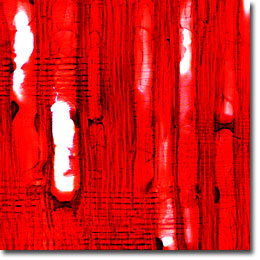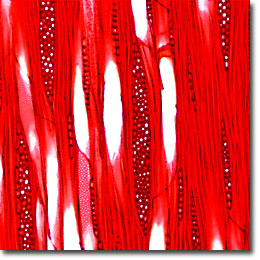The Black Cherry
Black Cherry (Prunus serotina) is a hardwood tree found primarily in the eastern half of the United States, from the Midwest plains to the Atlantic Ocean and from the Great Lakes to the Gulf of Mexico. The tree also occurs at high elevations in Mexico. The sapwood is white to light reddish brown, while the heartwood ranges from light to dark red-brown.

Cross Section

Radial Section

Tangential Section
Black cherry is a member of the Rose family of deciduous and broadleaf evergreen shrubs and trees that inhabit nearly the entire North Temperate Zone, with a few reaching to the Andes. The Prunus genus comprises over 400 species and includes all of the plums, cherries, apricots, peaches, and almonds in addition to the Japanese flowering cherries and similar shrubs. Flowering cherries require full sun and reasonably moist and well-drained soil. The life span of this family is relatively short due to susceptibility to various insects and diseases.
This tree does not produce the fruit that shares its name, however it does produce a fruit used to flavor brandy and rum from which the common names rum cherry and whiskey cherry are derived. Black cherry wood has a reddish brown color and luster when properly finished and often is the choice for fine cabinets. Because the wood demonstrates low shrinkage rates and is relatively free from warping and checking, it is often the best choice for manufacturing fine furniture, professional and scientific instruments, piano actions, and interior trim in buildings and boats.
Microscopic examination of iron-alum hematoxylin and safranin stained thin sections reveals numerous vessels and simple perforation plates with spiral thickening. Inter-vessel pits are 7 to 10 micrometers in diameter and broad-oval to orbicular or angular (through crowding) in shape. Parenchyma is very sparse and confined to occasional cells, while fiber tracheids are thin and thick-walled and medium to coarse in texture. The rays are unstoried and generally 3 or 4 seriate although 1 to 6 seriate is the broader range (both homocellular and heterocellular).